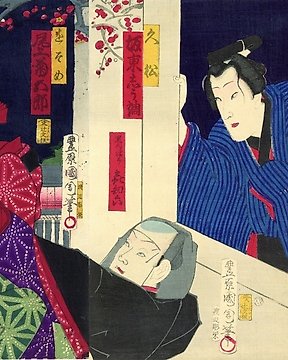
Triptyque original imprimé sur bois - Papier - Toyohara Kunichika (1835-1900) - Scene from the play "Ozome Hisamatsu ukina no yomiuri" 於染久松色読販 - Japon - 1874 (Méiji 7)
Nº 83662005

Nº 83662005

Original woodblock print triptych - Paper - Inoue Yasuji (1864-1889) - "Aishū Uraga Kan'nonzaki rikukaigun taikou Undō" 相州浦賀観音崎 陸海軍對抗運動(Army-Navy Battle Exercises at Soshu Uraga Kannon Cape) - Japan - 1885 (Meiji 18)
Publisher by Matsumoto Heikichi
The signature says “Inoue Tankei ga”井上深景画”.
Reasonable condition, stains, thinning paper in some areas.
"Kanpeishiki 観兵式" began in 1868 (Keio 4th year / Meiji 1st year) when the Emperor Meiji took the throne and then visited the military parade of the escort corps at the Kato Training Ground in Kyoto. is.
It is said that the term "Kanpeishiki 観兵式" has been used since 1877 (Meiji 10).
In the Meiji era, His Majesty the Emperor led the former Japanese army as the commander-in-chief, "Generalissimo", and the military parade was held waiting for the arrival of the generalissimo, from the army to the generalissimo.
In the central part of this ukiyo-e, the person who is salute on a horse can be inferred to be Emperor Meiji.
See Museum of Fine Arts, Boston: https://collections.mfa.org/objects/161362
Inoue Yasuji(memo)
Yasuji (seen written as 安治, 安二 and 安治 and also known as Yasujirō 安治郎, his given name at birth) was Kobayashi Kiyochika's (1847-1915) only true disciple. He was born in 1864 as the son of a dry-goods merchant in Asakusa, and is said to have begun as an apprentice in the atelier of the famous print artist Tsukioka Yoshitoshi (1839-1892). The story goes that Yasuji encountered Kiyochika one snowy day – probably in the winter of 1878-79 – sketching a Sumida River landscape. After watching the artist for some two hours in silence, Yasuji struck up a conversation and in short order asked Kiyochika to take him on as a disciple.
By the time Kiyochika gave up Western-style landscapes in 1881, Yasuji had designed only eight prints in his own name, but he perpetuated his master’s style over the next three years, particularly in the format of small postcard-size prints, reaching a total of 134 by 1884, with his best known series of small prints being titled Tokyo meisho (Famous Views of Tokyo). He also created prints that were nearly identical to those of Kiyochika’s as in the example below.
Like his master, Yasuji would produce several versions of the same print, for instance, one at daylight and one at night. Yasuji’s landscape work has a greater clarity than that of his teacher, and tends to be less dramatic or sentimental. In 1884, however, he completely abandoned this style and turned to conventional nishiki-e triptychs depicting the sights and events of the day in the traditional heroic style, working under the name of ”Tankei 探景”, which the publisher Matsuki Heikichi bestowed on him in 1884. His death1 on September 14, 1889, at the age of twenty-five, is said to have greatly distressed Kiyochika.
Roberts, in his Dictionary of Japanese Artists, comments: "Had he not died so young, [he] might have revived the ukiyo-e school.
Comment acheter sur Catawiki ?
1. Découvrez des objets d’exception
2. Faites la meilleure offre
3. Effectuez un paiement sécurisé